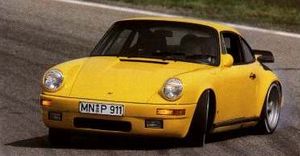.
RUF CTR - 1987-1993

| |
| RUF CTR | |
|---|---|
| RUF | |
| aka | RUF Yellowbird |
| Production | 1987 - 1993 |
| Class | Sports Luxury |
| Body Style | Coupe |
| Length | 4292 mm |
| Width | 1778 mm |
| Height | 1270 mm |
| Wheelbase | 2286 mm |
| Weight | 1550 KG |
| Transmission | 6-speed Manual |
| Engine | 3.3 litre, twin-turbocharged flat-six Boxer |
| Power | 469 hp @ 5950 rpm |
| Similar | Koenig Ferrari Testarossa Gemballa Avalanche AMG SL500 Hammer |
| Designer | Alois Ruf |
The RUF CTR, dubbed the "Yellowbird" for it's characteristic paint scheme, was a supercar built by RUF and based on the Porsche 930.
Beating Porsche at Their Own Game
In 1987, Porsche released their 'world-beating' 959. Or so they thought. But they faced competition from within Germany, from a tiny company in Pfaffenhausen, named RUF. The Porsche world was about to be turned upside down.
Their weapon of choice was named the 'CTR', a lurid yellow 911-based special, featuring a stripped-out interior, full roll cage, disc brakes, forged alloy wheels - and best of all, a 469 BHP engine, based loosely on the 3.3 litre plant found in the Porsche 930. The powerplant was enough to fire the car to 60 mph in less than five seconds, and on to a top speed of 211 mph - a production car record at the time.
The RUF Process
RUF revelled in the publicity gleaned from the production car world record, and on the back of which took 28 orders for RUF CTRs.
Each factory CTR originated as a 911 'narrow body' shell from the Porsche factory in Stuttgart. The bare shells were then transported to RUF, where the conversion from Dr. Jekyll to Mr. Hyde would take place. Firstly the body was painted in any colour specified by the owner. Then the fabrication would occur - the suspension and brakes, body panels, glass, roll cage, engine and transmission would be placed into the car. Each powerplant was blueprinted, and again originated as stock motors from Porsche.
Once the above was completed, the interior would be inserted. The interior was either a stripped-out tin can, or a lavish road-going palace, depending on the specification of the buyer. A uniform set of components featured in each interior - firstly, the leather-covered, three spoke RUF branded steering wheel, and secondly, the integrated roll cage, only identifiable by slightly wider pillars over the standard 911.
However, the changes over the 911 were not only internal. RUF set about gently modifying the exterior, to give the car an exclusive look. The modifications began with the alloy wheels, the CTR premiering the now-famous RUF design, and finished with a bespoke bodykit. The sills were deepened, and slotted valances, front and rear, were specified. On early prototypes, small triangular air vents can be seen above the rear wheels, designed to cool the engine. However, at high speeds, RUF engineers discovered that these actually sucked air out of the engine, prohibiting complete combustion. They were quickly removed from production cars.
Innovations
The CTR made use of many new techniques and processes, which RUF could do due to the low volume of production. For a start, aluminium panels were used to keep weight to a minimum - in the end, aluminium was the material of choice for the doors, bonnet and fron wings.
RUF teamed up with Dunlop, the prominent British tyre manufacturer, to develop a high-speed tyre that would cope with the breath-taking performance of the CTR. In a similar vein to its arch-enemy, the Porsche 959, the car made use of the Denloc system, which also enabled the car to drive with a flat tyre, due to stiffer sidewalls.
Massive 330 mm, four-pot Brembo disc brakes were fitted all around the vehicle to provide the masses of negative acceleration neccessitated by such a high-performance 911.
Statistics and Information
- The RUF Yellowbird was made famous amongst Porsche fanatics by the production of 'Faszination', a short film in which RUF's test driver, Stefan Roser, drove the original Yellowbird around the Nurburgring Nordscheife. The car lapped the track in around eight minutes, despite powersliding around many of the corners.
- Although RUF built only 28 official CTRs (as identified by a RUF-specific VIN), a number of other cars were built using customers' own cars as bases. Due to factory records being lost in a fire, it is difficult to say just how many cars were converted.
- Power - 469BHP delivered at a peak of 5950 rpm.
- Torque - 409lbft at 5950 rpm.
- The CTR benefitted from a power to weight ratio of 139.3 BHP per litre (or 407.8 BHP per ton).
- The 0-60 dash was dispatched in 4 seconds dead, with the quarter mile taking only 11.4 seconds.
|
Recent/Current/Future:
| ||
|
Previous:
| ||
|
Concept:
| ||
| edit this template |
